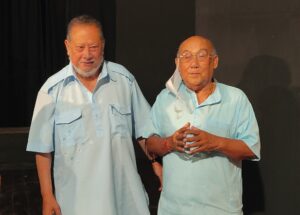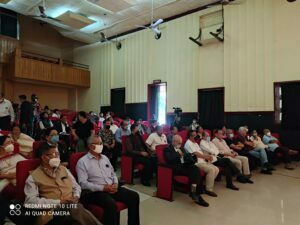‘Manipuri Cinema’, a book written by Meghachandra Kongbam, a renowned film critic and a member of International Federation of Film Critics was launched on Sunday by legendary Theatre director and playwright Ratan Thiyam at JN Manipur Dance Academy, Imphal.
TFM Report By Keisham Donny
Aesthetics played a central role in the first phase of Manipuri Cinema even though early Manipuri filmmakers could not acquire sound technical knowledge of film production, opined the legendary theatre director and playwright Ratan Thiyam.
The doyen of Manipuri theatre and maestro of dramatic spectacle, expressed this view while launching ‘Manipuri Cinema’, a book written by Meghachandra Kongbam, a renowned film critic and a member of International Federation of Film Critics at JN Manipur Dance Academy, Imphal on Sunday.
Delving on the subject, Ratan Thiyam stated that during the early phase, Manipur could indeed deliver outstanding films to the world and lamented the current trend of crash commercialization of cinema in Manipur in recent times. He further wondered “what kind of films the future generation will deliver to the world”.

This work fills the literary vacuum on Manipuri cinemas: Makhonmani
Delivering the introductory and welcome address on the occasion, Makhonmani Mongsaba, national film and Sahitya Akademi awardee stressed on the importance of the book which encapsulates the finer details of Manipuri cinemas. He said this book has indeed filled the literary vacuum on Manipuri cinemas. The launch of this book coincided with the ongoing yearlong celebration of 50 Years of Manipuri Cinema since April 2021.
Mongshaba also painfully recalled the unfulfilled dream of late Rajkumar Bidursana Singh, the founding president of the Manipur Film Journalist/Critics Association who also attempted to write down the history of Manipuri cinemas. He succumbed to post COVID-19 complication last year.
Speaking on the launch day, the author Meghachandra Kongbam, said that the book is the culmination of his long years and struggle as film columnist in leading newspapers and journals of Manipur. The current work includes his contributions in the quarterly journal E-CineIndia and textual representations of his close associations with the pioneers of Manipur cinema.

Meghachandra Kongbam vividly described the five chapters of his book. The first chapter deals with the environment of cinema in Manipur before the advent of films in Manipur. The second chapter portrays the birth of Manipuri Cinema and the struggle of the pioneers. The third chapter focuses on the works of second-generation filmmakers of Manipur. The fourth chapter covers Manipuri Cinema in digital age. And, the final chapter brought out the issues of Manipuri Cinema in contemporary times.
Reel Versus Real lives, skillful narratives, ban on Hindi films, creative outbursts: Prof MC Arun speaks
Prof MC Arun of Manipur University succinctly captured the imagination of the audience towards the author and the book. Narrating his close association with the author since childhood, Arun highlighted the author’s love for Manipuri Cinema in every close encounter with him.
Drawing from the Hegelian analogy of the driving force of history as ideas every serious reader of the book could find out that the driving force of Manipuri cinemas is human emotions. Arun compared Meghachandra’s style of writing with that of Gangumei Kamei and NK Sanajaoba where all of them picked up a particular person and skilkfully narrates the historical account of the social reality of Manipur through that person. Arun points out that through this book one could know the real story behind where a film based on Dr Kamal’s Madhavi was abandoned and not released till date. Stressing on the self-sacrifice of Madhavi in the actual novel and the self-sacrifice of Dhirendra in the reel Madhavi, Arun captured the audience’s attention by comparing Dhirendra of the reel Madhavi with RK Meghen who was also present in the book launch, on a lighter note.

Further, Arun stressed on the need to provide a free space in Manipuri cinema for creative outbursts which at the time is facing extreme censorship from the powers that be.
Arun also spoke on an interesting story behind the ban on Hindi films by the armed political groups of Manipur. The ban on Hindi film started not as an act of defiance against Indianisation at the beginning. Rather, the ban on Hindi film started in the form of a homage to a “fallen son of the soil who hated Hindi film”. One particular armed political group appealed not to showcase Hindi films in the cinema halls of Manipur only till the days of mourning was over. However, the Assam Rifles retaliated with forced display of Hindi films with loudspeakers in their designated camps. Due to the alleged high handedness of the Assam Rifles, the armed political group of Manipur counter retaliated with a complete ban on Hindi films and the ban continues till date.
M Joy Singh, IAS Commissioner (Art& Culture/IPR), President of Manipur Film Journal And Critic Association who presided over the event lamented about the decay of Manipuri cinema at the end of the innings of the 50 Years of Manipuri Cinema and hopes that in the coming new inning Manipuri cinema should surpass its past glory. The book launch received full packed attendance from different walks of life including scholars, film makers, artists, and film lovers.
